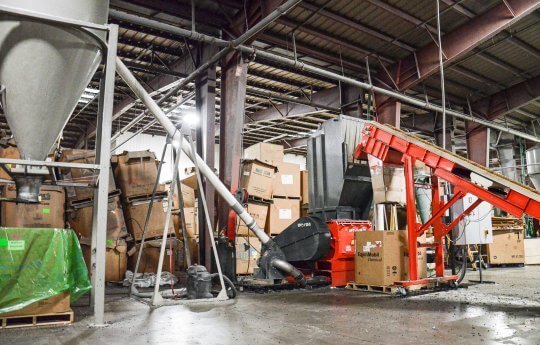WSM 300 / 600


Granulators, or cutting mills, are typically used as secondary shredders within a multi-stage recycling plant. The material has already been pre-shredded. Now it is to be granulated to the desired final size. The rotor speeds are therefore faster. A material ram is not required. All machines feature heavy-duty steel construction, easy maintenance access and high throughput rates. The most common applications include the secondary shredding of films, canisters, thin-walled pipes, profiles, bumpers, injection molding waste, or deep-drawn parts.
The spherical roller bearings used for the bearings of the cutting mill rotor are arranged in steel pillow block housings located on the outside and separated from the grinding chamber. This has the advantage that no dust or material can leave the grinding or cutting chamber in an uncontrolled manner and damage the bearings. Both bearings can also be easily relubricated and are provided with grease outlets.

Users can choose between different rotor variants for individual material adjustment. In all rotors, both the rotating cutting knives and the stationary knives are angled toward each other. This results in a targeted cutting gap – across the entire working width. In addition, the shear cut not only ensures a constant regrind size, but also has a positive effect on the noise level.

To ensure optimum power transmission from the drive motor to the rotor of the granulator, even in continuous operation, a reinforced flywheel design is used. This makes it possible to cut and grind particularly hard feed material without any problems.

The upper part of the grinding chamber as well as the infeed hopper can be tilted backwards. This allows convenient access to the lower part of the grinding chamber, where the rotor, rotating knives, and front/rear stationary knives are located. The screen is also easily accessible, which reduces maintenance times to a minimum.

Unfortunately, granulators are inherently noisier than slow-running single-shaft shredders due to their high rotor speeds. For this reason WEIMA offers solutions to reduce noise emissions. These include a special noise reduction hopper, which also reduces vibrations, as well as a double bevel cut technology on the rotor. Even more effective is a complete sound enclosure. Such an enclosure reduces the emission of loud noises many times over. This has a positive effect on your employees and the working environment.

If you are looking for a flexible granulator solution, you will find it at WEIMA. With our machines you can granulate pre-shredded materials such as pipes, automotive parts, blow molding products such as PET bottles, PP/PE bottles, canisters, buckets, films, and other flexible materials. With a simple changeover, even start-up lumps or other thick-walled materials can be shredded. In all cases, you get a high-quality, homogeneous regranulate that meets the high requirements of a modern recycling plant.

The screen size defines the material size after granulation. The smaller the hole diameter, the finer the material to be ground. If a screen must be removed for maintenance or changing material flows, this can be done easily by means of a threshold exchange mechanism.

As a rule, WNZ and WSM machines function as secondary shredders of a two-stage shredding plant or recycling line. The particularly wide and high opening of the feed hopper facilitates filling of the machine. A lamella curtain serves as splash protection. The material can be fed manually or automatically by conveyor belt. For maintenance purposes, the entire hopper can be folded away via a tilting mechanism with safety limit switch, giving free access to the rotor.

As a standard feature, the side of the machine is equipped with a round suction port through which the granulated material can be extracted. If desired, a discharge solution by screw conveyor can also be implemented.

WEIMA WSM cutting mill with air extraction and big bags for regranulate collection
The cutting geometry is the heart of a secondary shredder. To ensure that it is always perfectly suited to the material being fed and that the cutting gap is correct, the cutting knives can be quickly and conveniently readjusted outside the machine with the aid of a setting gauge. Stationary knives can also be reversed on both sides. This means that once the first knife edge has worn out, a further edge is available simply by turning it over. Downtime, fines, and dust generation are thus reduced to a minimum. The result is a regrind of uniform size.
